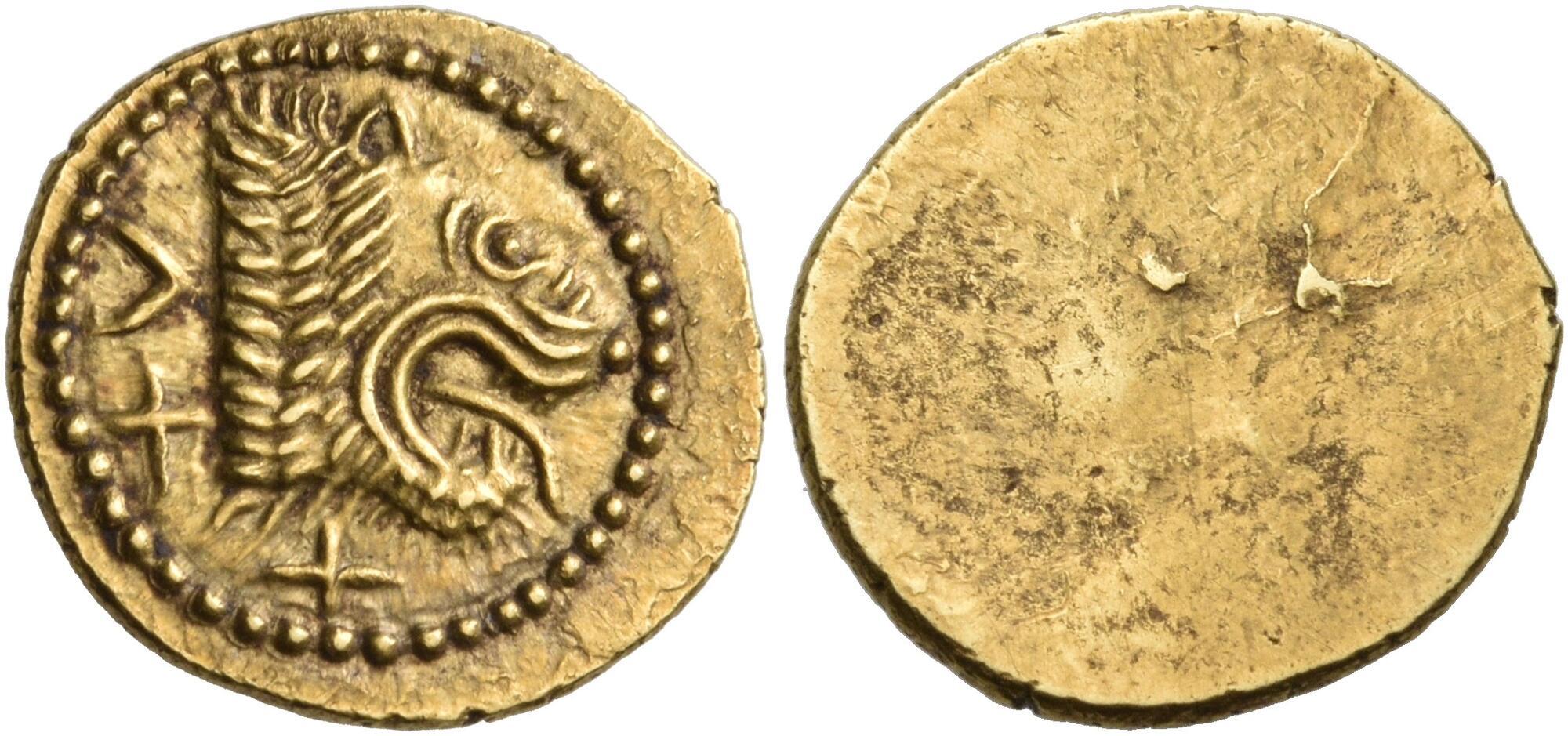Populonia, gold, 25 asses (300-250 BCE)
From SILVER
300 BCE - 250 BCE Gold 1,431 kg
Description
| ObverseInscription or printing placed on the obverse.: | X - XV Lion's head to right, with open jaws and protruding tongue |
| ReverseInscription or printing placed on the reverse.: | Blank |
Mint and issuing power
| MintIdentifies the place of manufacture or issue of a numismatic object.: | Populonia | Ancient regionAncient region.: | Etruria | Modern countryModern country: Italy | AuthorityIdentifies the issuing power. The authority can be "pretended" when the name or the portrait of X is on the coin but he/she was not the issuing power. It can also be "uncertain" when there is no mention of X on the coin but he/she was the issuing power according to the historical sources: |
Chronology
| FromIdentifies the initial date in a range assigned in a numismatic context. | 300 BCE | toIdentifies the final date in a range assigned in a numismatic context.. | 250 BCE | PeriodTime period of the numismatic object.: Hellenistic 323-30 BC |
Physical description
| MetalThe physical material (usually metal) from which an object is made.: | Gold |
Median weightMedian of the weights of numismatic objects (in grams). in grams | 1.40 | DenominationTerm indicating the value of a numismatic object. Examples: tetradrachm, chalkous, denarius.: | 25 asses | StandardStandard.: |
Image

S 1681 - Populonia, gold, 25 asses (211-206 BCE).jpg [1]
References
| Die study referencePublication of the study: | Vecchi 20121Vecchi 2012, p. 102-105, Giannoni 20162Giannoni 2016, Giannoni 20183Giannoni 2018, p. 2. | ||
| Coin series referenceReference to coin series study: | Sear I4Sear I, n° 264, HN Italy5HN Italy, n° 128, HGC 16HGC 1, n° 76 | ||
| Coin series web referenceCoin series web references: | |||
Obverse dies distribution
| FrequencyFrequency of specimen in distribution. ᵖ | Number of obversesNumber of obverse dies. ᵖ (o) | % (o) | Number of coinsNumber of coins. (n) | % (n) | Die nameName(s) of the die(s). |
| 1 | 2 | 40 | 2 | 4.26 | 3, 4 |
| 2 | 2 | 40 | 4 | 8.51 | 2, 5 |
| 41 | 1 | 20 | 41 | 87.23 | 1 |
| Total | 5 of 5 | 100 | 47 of 47 | 100 |
Reverse dies distribution
no distribution is available
Quantification
| Number of obversesNumber of obverse dies. ᵖ (o) | 5 | Number of singletons (o1)The number of singleton coins. ᵖ | 2 |
| Number of reverse diesNumber of reverse dies. (r) | Number of coinsNumber of coins. (n) | 47 | |
| Coins per obverse dieNumber of coins per obverse die. (n/o) | 9.4 | Coins per reverse dieNumber of coins per reverse die. (n/r) | |
| Reverse per obverse ratioRatio of obverse dies divided by reverse dies. (r/o) | Percentage of singletons (o1)number of coins (n) divided by the number of singletons (o1) ᵖ | 40 % | |
| Original number of dies (O) (Carter 1983 formula)The estimation of the number of coins according to Carter 1983 ᵖ | 5.11 | Coins struck if 20,000 as average productivity per dieCoins made if the average productivity for obverses (according to Carter) is 20,000. ᵖ | 102,200 |
| Original number of dies (O) (Esty 2011 formula)The estimation of the number of coins according to the singleton formula in Esty 2011 ᵖ (O) | 5.6 | Survival rate if 20,000 as average productivity per dieSurvival rate if average productivity is 20,000. ᵖ | 0.00046 |
| Coverage (o = % of O) (Esty 1984 formula)Esty 1984 - coverage (% of O) ᵖ (o = % of O) | 95.74% | Die productivity if survival rate 1/2,000Average productivity if survival rate is 1/2,000. ᵖ | 18,395.3 |
| Weight of silver (in kg) if 20,000 coins per die (O = Carter formula)Carter 1983 * Median weight * 20000 (*10 if gold or electrum) ᵖ | 1,431 kg <br /> 1,431 kg | Die productivity if survival rate 1/5,000Average productivity if survival rate is 1/5,000. ᵖ | 45,988.26 |
Remarks
Most likely one single workstation
References
- ^ Vecchi, Italo (2012), Etruscan coinage: a corpus of the struck coinage of the Rasna, together with an historical and economic commentary on the issues (gold, silver and bronze), Milan, Ennerre, 590 p. (135 pl.).
- ^ Giannoni, Luciano (2016), "Alcune valutazioni statistiche sui conî degli aurei populoniesi con testa di leone", OMNI, n° 10, p. 9-17
- ^ Giannoni, Luciano (2018), Schede quantitative delle emissioni monetali etrusche, unpublished manuscript, s.l., 13 p.
- ^ Sear, David R. (1978), Greek coins and their values. Vol. I, Europe, London, xl, 316 p.
- ^ Rutter N. Keith et alii (eds.) (2001), Historia Numorum Italy, London, xvi, 223 p., 43 pl.
- ^ Hoover, Oliver D. (2018), The Handbook of Greek Coinage Series, Volume 1. Handbook of Coins of Italy and Magna Graecia, Sixth to First Centuries BC., Lancaster-London, 2018, lxi, 527 pages, 23 cm